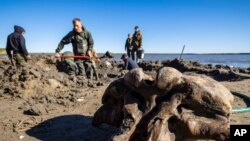Russian scientists are digging out fragments of a well-preserved woolly mammoth skeleton found by reindeer herders a few days ago at a lake in northern Siberia.
The herders initially found parts of the animal’s skull, lower jaw, several ribs and foot fragments with sinews still intact on the shores of Pechevalavato Lake.
Scientists are excavating for the remaining fragments of the prehistoric animal in lakeside silt, which is likely to take a significant amount of time and special equipment.
“According to the first information we have, the whole skeleton is there,” said Dmitrii Frolov, director the Arctic Research Center of the Yamal-Nenets Autonomous District, in a report by The Siberian Times.
"Judging by the pictures, this was a young mammoth, but we’ll have to wait for tests to give the exact age,” he said.
Finding the complete skeleton of a mammoth is relatively rare, Yevgeniya Khozyainova of the Shemanovsky Institute in Salekhard said in televised remarks.
The ice age animal is thought to have gone extinct around 10,000 years ago and closely resembles today’s Asian elephants, with the exception of a thick coat of brown hair.
The thawing of permafrost in regions like Siberia, where the ground normally stays frozen throughout much of the year, has revealed enormous amounts of organic matter, including dead plants, microbes and animals.
Siberia has seen record-breaking heat during the first half of this year, driven by climate change.







